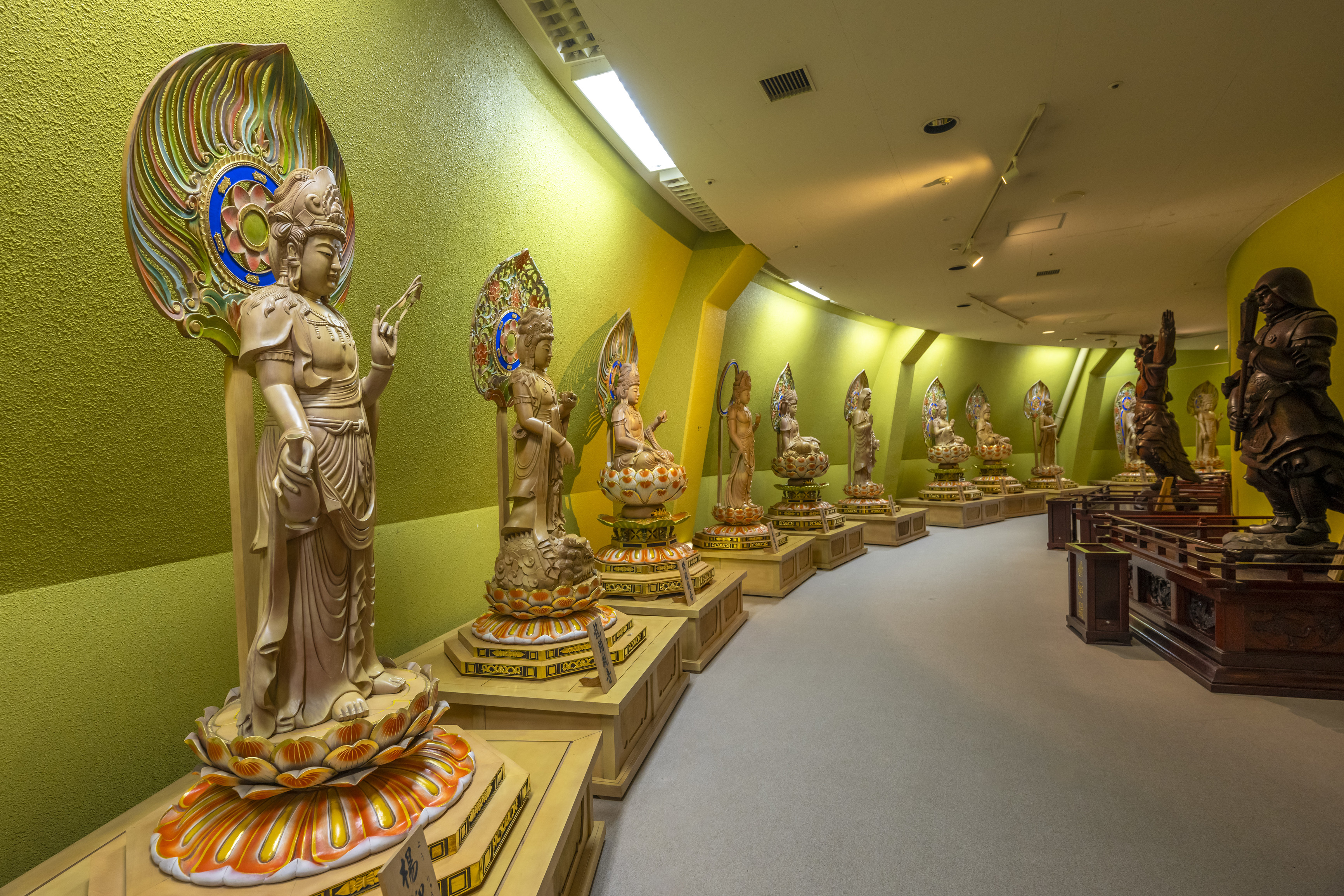
Sendai Daikannon
仙台大観音- Sendai StationSenseki LineJōban LineTōhoku Main LineSenzan Line
- 32 minutes bus drive to In front of Sendai Daikannon
- Walk 2 minutes
Towering over the northern hills of Sendai, Sendai Daikannon is one of the tallest statues in Japan and a powerful symbol of compassion and wisdom. Depicting the White-Robed Kannon (Byakue Kannon), she is revered as the “Mother of All Buddhas”, a compassionate figure said to give rise to all enlightened beings. She is also one of the revered Thirty-Three Forms of Kannon in Japanese Buddhist tradition.
In her right hand, she holds the nyoi hōju, a wish-fulfilling jewel believed to grant the sincere desires of those who pray to her. In her left, she carries a vase filled with the water of wisdom and virtue, which she pours over the faithful to bestow clarity and insight.
The statue was built in 1991 to commemorate the 100th anniversary of Sendai’s city status, standing at a symbolic height of 100 meters.
Goshinden (Hall of the Sacred Heart)
The Goshinden is the heart of the Kannon statue. Inside the golden, radiant sacred pagoda at its center are enshrined two hidden sacred objects (hibutsu): the wish-fulfilling jewel (nyoi hōju) held in Kannon’s right hand, and the Dainichi Nyorai (Cosmic Buddha).
The nyoi hōju, one of the hidden treasures, is a miraculous jewel believed to grant wishes in accordance with the hearts of those who pray. It bestows blessings such as wealth, virtue, and wisdom, fulfilling the hopes of many worshippers. The pedestal that supports the jewel is made of lapis lazuli, a beautiful blue stone symbolising the Water of Wisdom.
108 Inner Statues of the Buddha
Within the inner sanctuary of the Sendai Daikannon, visitors will find the Hyakuhachi Tainaibutsu - a solemn passage lined with 108 Buddha statues. This sacred number represents the 108 earthly desires (bonnō) believed in Buddhism to cloud human judgment and keep us bound to the cycle of suffering.
According to Buddhist teachings, ten of these desires are actively influencing us in daily life, while the remaining ninety-eight lie dormant, ready to surface under certain conditions. These hidden desires are part of our nature, but they can be understood, overcome, and ultimately extinguished through mindfulness and spiritual practice.
The Hyakuhachi Tainaibutsu offers not only a physical experience but a deeply personal and transformative one - an opportunity to walk the Buddha’s path in silence and reflection.
The Twelve Divine Generals
Within the halls of Sendai Daikannon stand the Twelve Divine Generals (Jūni Shinshō), fierce warrior deities revered in Buddhism for their protective powers. Also known as the Twelve Yaksha Generals, they are believed to be manifestations of Yakushi Nyorai, the Medicine Buddha, who vowed to relieve suffering and grant peace, health, and prosperity to all beings.
Each general is depicted wearing armor, holding weapons, and exuding a powerful presence. They are not only guardians of the Yakushi Sutra and its followers but are also associated with the twelve zodiac signs of the Chinese calendar. Each deity protects a specific zodiac animal, watching over those born under that sign and offering blessings of good health, safety, and fortune.
The Twelve Divine Generals are also said to guard the twelve hours of the day and twelve directions, constantly surrounding the world with their protection. Visitors to the shrine often pray to the general linked to their birth year, seeking blessings for healing, happiness, and the removal of misfortune.

33 Kannon
The Thirty-Three Kannon are revered manifestations of Kannon Bodhisattva, believed to appear in various forms to respond compassionately to the diverse troubles and needs of all beings. This concept teaches that Kannon adapts through thirty-three different transformations, each uniquely offering guidance and relief from suffering.
Among these forms are well-known figures such as the White-Robed Kannon, the principal image, along with the Willow Branch Kannon, Medicine-Offering Kannon, and Water Moon Kannon. Each manifestation embodies a specific aspect of compassion and wisdom, helping followers overcome challenges and find peace.
The thirty-three forms also include more symbolic representations, like the Lotus-Holding Kannon and Universal Mercy Kannon, emphasizing Kannon’s boundless ability to aid humanity. According to Buddhist teachings, these manifestations can also appear as other deities like Taishakuten (Indra) or Bishamonten, delivering teachings in various guises.
Mizuko Kuyo (Mizuko nursery)
Mizuko Kuyo is a heartfelt memorial ceremony dedicated to unborn children who were meant to be born but, for various reasons, did not come into this world. The Mizuko Kannon - a compassionate deity - offers solace and comfort to these small, innocent spirits. It is believed that by entrusting these spirits to the loving care of the Mizuko Kannon, much like a mother gently cradling her peacefully sleeping child, their souls find peace and compassion. This memorial honors and consoles those unborn lives, helping families find healing and closure for past sorrows.
Hotei-sama
You can touch Hotei-sama - the "Laughing Buddha" - and gently rub the area of his body corresponding to your health concerns. This practice is believed to bring good luck, health, and well-being.
At Hey Japan!, we strive to keep the places listed on our website as current as possible. However, it is important to note that location owners or management may make changes to their plans, including canceling events, altering opening times, or modifying admission requirements, without prior notice. To ensure that you have the most accurate information, we recommend checking official websites before visiting any location.
Last Updated:











